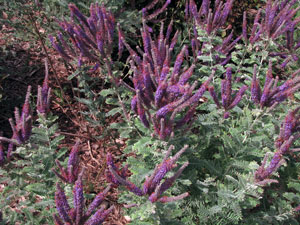Resource Library
Plant of the Week: Lead Plant
The University of Arkansas System Division of Agriculture does not promote, support or recommend plants featured in "Plant of the Week." Please consult your local Extension office for plants suitable for your region.
Plant of the Week
Lead Plant
Latin: Amorpha canescens

Native plants are becoming an increasingly important part of the American landscape. While most of the emphasis amongst enthusiasts of natives seems to concentrate on wildflowers, woody shrubs too deserve closer attention. Lead plant (Amorpha canescens), a native shrub of the prairie states, has potential as an interesting addition to the garden.
Lead plant is a deciduous shrub belonging to the bean family that grows 2 to 3 feet tall with a spread to 4 feet. It forms a deep tap root and an irregular, open framework of herbaceous branches that become woodier as plants age. Leaves are pinnately compound and 4 to 8 inches in length with 50 or small leaflets about half an inch long. The leaves are covered with a fine grayish pubescence giving the plant a pewter-colored appearance.
In late spring, terminal 6 inch long spikes - often forming a cluster of spikes - produce lavender to purple blossoms that open from the base to the top of the spike. Individual flowers are enclosed in a pubescent calyx, which produces a single upper petal that wraps around the 8 exerted stamens that are themselves showy on close inspection. The Latin name "Amorpha" means "without shape," as in amorphous, and refers to the single petal of the flower, which is atypical for a legume blossom. The species epitaph means "gray hairs."
Lead plant is found throughout the prairie states from Texas and Arkansas in the south to Illinois and Montana in the north. It typically is associated with drier sites in the prairie but will also occur in lightly shaded sites in oak groves.
The late Carl Hunter, in his Trees, Shrubs & Vines of Arkansas, says lead plant is so named because of its gray, lead-colored leaves. But according to the folklore of the Internet, the name derives from an old belief that it is an indicator plant for lead deposits. Lead mining was a highly touted venture in the Arkansas Ozarks during the late days of the 19th and early 20th centuries, and grubstake miners and small farmers may well have used the presence of the plant to help them determine where to dig, using the long-held belief in the doctrine of signature used by native herbalists. The doctrine of signature is based on the belief that God sends signs in nature to help mankind cure its ills - and certainly poverty must rank high on the list of ills needing cured.
North central Arkansas, especially Newton and Boone Counties, were mining hotspots a century ago because they were crisscrossed by at least two geologic faults where zinc and lead deposits occurred. Ponca, known to all visitors of the Buffalo River, was founded as a lead mining town and had a population of over 3,700 in its heyday. Twenty-five mostly small lead and zinc mines have been operated in Newton County. The original Lead Hill in Boone County now lies beneath Bull Shoals Lake. The modern town was relocated to the top of the hill in the 1950s. Lead oars were hauled by ox carts to the closest railroads and shipped to smelters in other states for processing. The relatively low concentration of galena - the mineral from which lead is extracted - resulted in the abandonment of Arkansas mines after WWII in favor of mines in southeastern Missouri, where the ore is more concentrated, or to the intermountain west, where galena is mixed with silver.
Lead plant is an easy plant to grow in sunny, well-drained sites. It is adaptable to a wide array of soil types and will even grow in clay soils so long as drainage is provided. Being a prairie plant, it tolerates fire, so pruning the plant back to the ground every couple years will make it fuller and help restrain its tendency to be a bit gawky. It can be used in the shrub border, mixed with perennials, or planted in areas where the plant must fend for itself after established. It is not common in the nursery trade but is available from purveyors of native plants.
By: Gerald Klingaman, retired
Retired Extension Horticulturist - Ornamentals
Extension News - May 27, 2011
The University of Arkansas System Division of Agriculture does not maintain lists of retail outlets where these plants can be purchased. Please check your local nursery or other retail outlets to ask about the availability of these plants for your growing area.